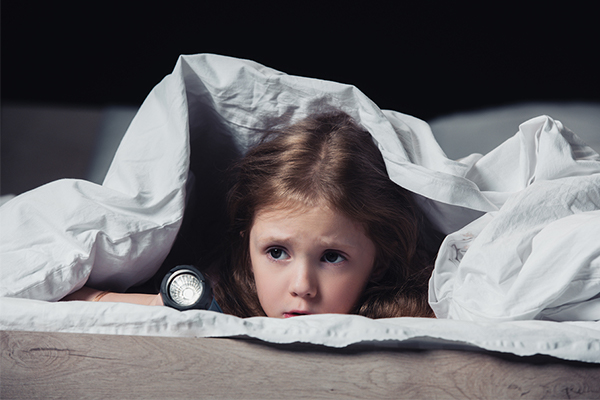Your child cries out during the night. When you rush into the room, your child looks up at you with big, tear-filled eyes, and points to a shadow on the ground. He or she clings to you, and doesn’t want you to leave.
If this is happening when your child is about 2 or 3, it’s a safe bet that your child may have developed a fear of the dark.
It’s pretty common at this age, said Dr. Alex Mabe, a psychologist at the Children’s Hospital of Georgia, and it’s completely developmentally normal. “Your child’s brain is mature enough to begin to realize other things in the world could be bad. They have thoughts about separation, fears of personal safety, worry about kidnappers or burglars. Their imagination creates monsters, and they may also have dreams that bother them.”
Most kids will actually outgrow fear of the dark by ages 4 to 5, helped along with some specific strategies. But about 20% of kids will have a persistent fear of the dark. “It’s not always so easy to unlearn those startled, anxious, fearful responses,” said Mabe. “Parents should be aware that these persistent fears can be difficult to help a child overcome, which is why it’s best to try to calm things down early.” Here’s how:
- Read between the lines. Your child may not say right out that he or she is afraid of the dark. But some possible signs that your child is anxious or afraid about going to bed include being fussy, have trouble going to sleep, calling out for mom or dad during the night, frequently asking to use the potty or get a drink of water, and complaining about not feeling good.
- Be a detective. Once you think your child might be afraid of the dark, try to figure out what specifically he or she is afraid of. Is it being separated from mom or dad, or being afraid something will happen to a parent? Are they afraid of kidnappers or burglars? Are they imagining monsters or other scary creatures? It’s only when you know exactly what your child is afraid of that you can help.
- Reassure, but don’t overdo it. When you calm your child’s fears, make it short, simple and matter-of-fact. Don’t go overboard with your reassurance, says Mabe, because it could make the child think there’s something dangerous that mom or dad isn’t telling me. For example, assuring your child that there are no monsters, but then taking the time to look in the closet, under the bed or behind the door sends a confusing message. Also, don’t tell your child that fears are silly, or become irritated or angry, since those responses will likely only make fears worse.
- Add these to your child’s bedroom. If your child asks for more light, it’s completely OK to add a nightlight or lamp to the bedroom, or to leave the door open. But since we all tend to get better sleep in a darker room, over time, you can try to gently ease your child back to just a nightlight. You can also try using a white-noise machine if sounds are waking up and bothering your child.
- Keep a good bedtime routine. A routine could look like this, said Mabe: A parent brings the child to bed, where they snuggle and spend a few minutes reading books, singing songs, telling stories or saying prayers. “This creates a very gentle, calming-down period where you’re present in the child’s room,” said Mabe.
Then, ideally, the parent says good night and leaves before the child is fully asleep. By doing this, you’re teaching your child to fall asleep on his or her own. “Otherwise, if you stay there until your child falls asleep, your child begins to believe he or she can only go to sleep if a parent is present,” said Mabe. “This will mean that they will wake up looking for mom or dad to help them go to sleep.”
Even if your child wakes up in the middle of the night, it’s best to settle them back down, give comfort, and leave when they’re sleepy, but before they fall asleep.
For Older Children
If your child is older than four or five and is still scared of the dark, Mabe says that studies have found that a combination of stories and toys have had good results. For example, read stories about children or animals that have overcome a fear of the dark. Then introduce a new toy animal or doll, explaining to your child that the toy is afraid of the dark and is having trouble sleeping. “Tell your child, ‘Your job is to help this teddy, and the good news is that the teddy can also protect you from danger,” says Mabe.
Kids seven and older can understand about fear and anxiety, so parents can teach them that we all have fears, that they don’t last forever, and that there are things we can do to calm ourselves down. For example, kids can learn to pace their breathing, relax their muscles and have positive thoughts. Parents can also help kids work through unrealistic thoughts, like fears of burglars breaking in, by talking about how secure and safe the house is.
“Fear of the dark is one of the most common fears children have,” said Mabe. “As parents, it’s our job to support them, to be calm and collected, and do what we can to help children with this very normal fear of the dark.”




